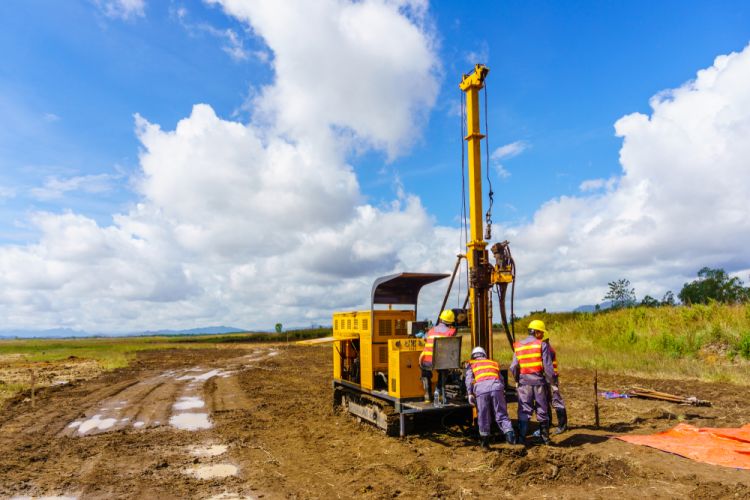Not known Facts About Geotechnical Engineering For Construction Projects
Not known Facts About Geotechnical Engineering For Construction Projects
Blog Article
How Geotechnical Engineering For Construction Projects can Save You Time, Stress, and Money.
Table of ContentsNot known Incorrect Statements About Geotechnical Engineering For Construction Projects Things about Geotechnical Engineering For Construction Projects6 Easy Facts About Geotechnical Engineering For Construction Projects DescribedThe 8-Second Trick For Geotechnical Engineering For Construction ProjectsOur Geotechnical Engineering For Construction Projects PDFsThe Greatest Guide To Geotechnical Engineering For Construction Projects
The function of geotechnical design dramatically takes care of understanding the attributes of dirt and rock, which might differ substantially by their thickness, moisture web content etc. These functions need to be taken a look at by geotechnical engineers to forecast their activities under various situations. The safety along with security of structures are influenced by soil conditions, making this evaluation required., in enhancement to exactly how they interact with constructions that have been set up on or within them, is one of the key explanations for why geotechnical engineering is vital.
Along with architectural preparation and building, geotechnical design is likewise important to the reconstruction and upkeep of pre-existing frameworks. Age-related degradation or added issues might affect a structure's stability and efficiency. Environmental defense is achieved with geotechnical engineering. Competence in air, water, and dirt quality upkeep is put to use by geotechnical engineers to decrease the negative effects of projects.
Infrastructure advancement, offshore design, passage construction, and deep foundations. Risk-based style and multidisciplinary teams. These elements will certainly maintain the area evolving and guarantee its ongoing value in the years to find. To sum up, geotechnical engineering is a crucial technique that protects the durability and integrity of civil infrastructure. Geotechnical engineers add to making structure tasks efficient around the world by understanding the behaviour of planet products and applying appropriate planning strategies.
Geotechnical Engineering For Construction Projects Things To Know Before You Get This
By examining soil, rock, and subsurface problems, geotechnical designers give vital understandings that assist in the design, building and construction, and maintenance of buildings and facilities.

Fascination About Geotechnical Engineering For Construction Projects
Lab testing: Establishing the residential or commercial properties of dirt and rock. Field testing: Conducting examinations on-site to assess problems. Evaluation and style: Using information to design structures, preserving wall surfaces, tunnels, and other structures. Several top-level building jobs have actually effectively used geotechnical design to guarantee their stability and security. :: The world's tallest building required a deep understanding of the underlying geology.

As a leader in geotechnical design, BECC Inc. is devoted to delivering cutting-edge and reliable options that satisfy the greatest requirements of quality and safety. For more info on exactly how BECC Inc. can sustain your next building task, contact us today and allow us help you construct on strong ground.
William Rankine, a designer and physicist, established an alternate to Coulomb's earth stress theory. Albert Atterberg established the clay consistency indices that are still utilized today for dirt category. In 1885, Osborne Reynolds recognized that shearing reasons volumetric expansion of thick materials and contraction of loosened granular products. Modern geotechnical engineering is claimed to have begun in 1925 with the publication of Erdbaumechanik by Karl von Terzaghi, a mechanical engineer and geologist.
Our Geotechnical Engineering For Construction Projects Statements
Terzaghi additionally developed the framework for concepts of birthing ability of structures, and the concept for forecast of the price of negotiation of clay layers as a result of combination. Later on, Maurice Biot completely established the three-dimensional dirt loan consolidation theory, prolonging the one-dimensional version formerly created by Terzaghi to much more basic theories and introducing the set of basic formulas of Poroelasticity.
Geotechnical designers check out and identify the residential or commercial properties of subsurface problems and products. They likewise make corresponding earthworks and retaining frameworks, tunnels, and structure foundations, and may manage and assess sites, which might additionally include site surveillance along with the threat evaluation and mitigation of natural risks - Geotechnical Engineering for Construction Projects. Geotechnical engineers and engineering geologists perform geotechnical investigations to get information on the physical buildings of dirt and rock hidden and beside a site to develop earthworks and foundations for proposed frameworks and for the fixing of distress to earthworks and frameworks triggered by subsurface conditions.
Geotechnical Engineering For Construction Projects for Dummies
Still, they are sometimes utilized to allow a rock hound or site link designer to be lowered into the borehole for straight visual and hand-operated examination of the dirt and rock stratigraphy. Numerous dirt samplers exist to satisfy the requirements of different design tasks. The standard penetration examination, which makes helpful hints use of a thick-walled split spoon sampler, is the most common method to gather disrupted samples.

Generally, the interface's specific geometry is unidentified, and a streamlined user interface geometry is thought. Finite slopes require three-dimensional designs to be evaluated, so most inclines are assessed assuming that they are considerably large and can be stood for by two-dimensional versions.
The Ultimate Guide To Geotechnical Engineering For Construction Projects
Developing the layout based on a functioning theory of actions prepared for under the most possible problems. Option of amounts to be observed as building and construction profits and computing their expected worths based on the working hypothesis under the most unfavorable problems.
Dimension of quantities and analysis of actual problems. Style adjustment per actual problems The observational method is suitable for building and construction that has actually already begun when an unanticipated development the original source takes place or when a failure or crash looms or has actually already happened. It is improper for jobs whose design can not be changed throughout building.
Report this page